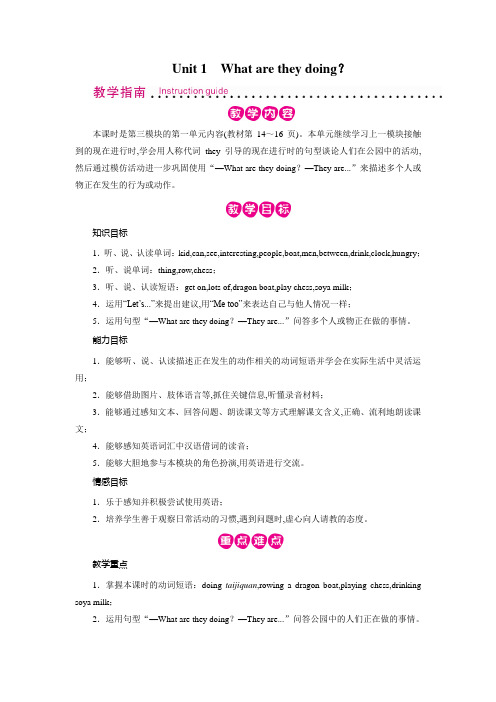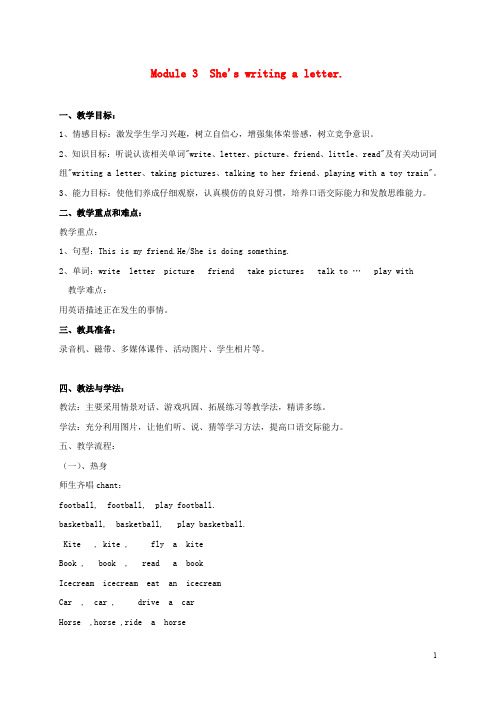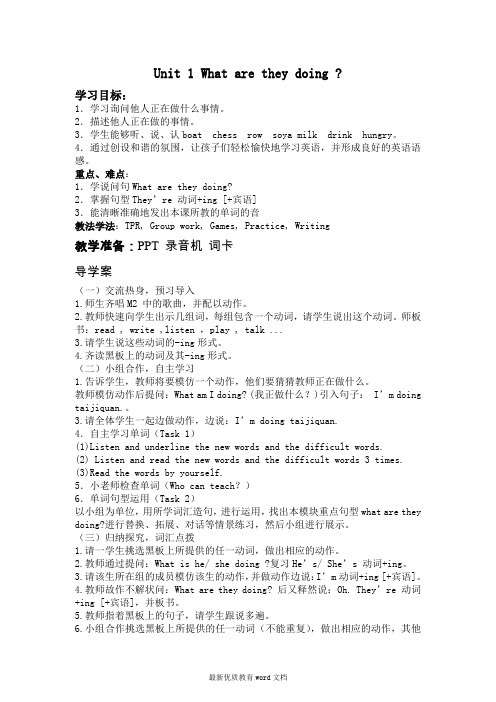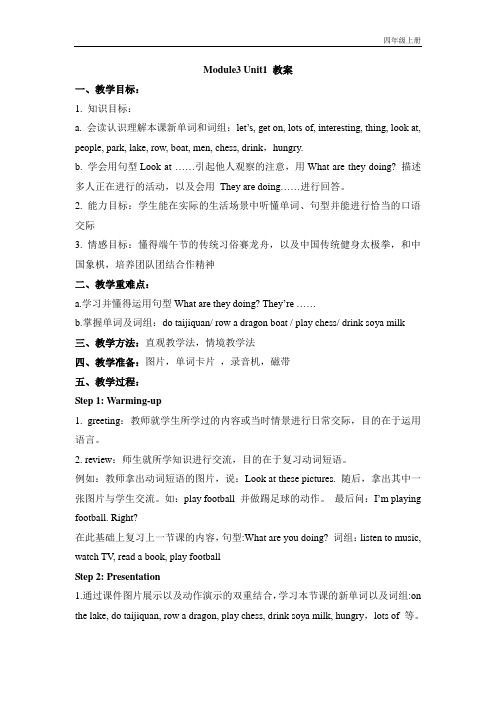M3U1外研社新版四年级上教案 module3 unit1
- 格式:doc
- 大小:73.00 KB
- 文档页数:2

Unit 1 What are they doing?【学情分析】The pupils of Grade 4 are so active that they like to do the actions. But they can't master too many words imediately. In this unit, there are lots of new words and phrases. So the teacher asked them to preview them. And the teacher designed many activites to draw their attention.【教学目标】1. Knowledge aimsa. Master the words “kid, interesting, people, boat, men, between, drink, clock, hungry”.(Because there are so many words in this unit, so I asked the pupils to preview the new words.)b. Know the phrases“do taijiquan, row a dragon boat, play chess, drink soya milk”.c.Ask and answer with”What are they doing? They are….”。
2. Ability aimsThe students can communicate with each other.3. Emotion aimsThe students love to communicate with others.【重点难点】1. New words and phrases.2. The PresentContinuous Tense.【教具准备】PPT课件、单词卡片、人物头像、CD-ROM【教学方法】情景教学、游戏、合作探究、任务型教学法【教学过程】Step 1: Warming up and revision1.Greeting. Classes begin. Good morning, boys and girls. How are you? I’m fine, too.2.Boys and girls. Let’s chant together, ok? Chant: two little black birds.(Two little black birds sitting on a hill, one named Jack and one named Jill, fly away Jack, fly away Jill, come back Jack and come back Jill.)3.You did a very good job. Boys, are you ready for the class? Girls, are you ready? Sit down, please.4.Ok, first let’s review.( Chant:Listen, listening. I’m listening to music. Write, write, writing. I’m writing a letter. Play, play, playing. I’m playing football. Talk, talk, talking. I’m talking to you. Ask and answer:What is he/she doing?)Step 2: New ConceptsLead in: What are they doing? What are the kids doing? Learn the new word: kid. Read one by one. Kids are equal to children.A.1.Let’ s watch and listen.2.This time, let’s follow.B.Look at the picture. Guess what it is. Bus Let’s get on the bus. We can see lots of interesting things. Interesting: play balloon.3.Let’s go! Look, there are lots of people in the park. People:three by three. What are they doing? They are doing taijiquan.4.Look! They are rowing a drgon boat. Boat:read quietly/loudly. Show me your fingure:boys spell, girls spell. Close your eyes, spell.5.Oh, look at them. This is a man, this is another man. They are men. Men:e prounce e. Ask anyone to spell and read. They are sitting between the trees. Boys/girls read. They are playing chess.6.Oh there are two girls. They are drinking soya milk. drink. Act and read. Ask the students to teach. Read: drink soya milk.C. Games:7.Now boys and girls, you should watch carefully. And quickly read the phrases.8.Well done. Are you tired. Let’s relax. Stand up, please. Act out the phrases. Sit down, please. Now I’ll ask some group come here to act.and you should answer me what they are doing?(The teacher give them some phrases on the paper.)10.You still want to play, yes? Now, guess what they are doing?D.11. We should return to our text. Now watch and listen carefully.Open your books, turn to Page 14. Let’s read.12. Practice these dialogue in your group. A fter that I’ll ask you to show it.Step 3:SummaryWhat have we learned today?Chant together:What are you doing? They’re doing taijiquan. What are you doing? They’re rowing a dragon boat. What are you doing? They’re drinking soya milk. What are you doing? They’re playing chess.Step4: HomeworkOn your way home, you may meet lots of people. Try to say what are the people doing.第二课时【教学目标】1 知识目标:A 学生能掌握购物时双方能使用的基本句型: can I help you ?how much is it?”“It; s. . . yuan. ”和学生能理解词汇flower dumping help buy,并能运用词汇buy。

Unit 1What are they doing?本课时是第三模块的第一单元内容(教材第14~16页)。
本单元继续学习上一模块接触到的现在进行时,学会用人称代词they引导的现在进行时的句型谈论人们在公园中的活动,然后通过模仿活动进一步巩固使用“—What are they doing?—They are...”来描述多个人或物正在发生的行为或动作。
知识目标1.听、说、认读单词:kid,can,see,interesting,people,boat,men,between,drink,clock,hungry;2.听、说单词:thing,row,chess;3.听、说、认读短语:get on,lots of,dragon boat,play chess,soya milk;4.运用“Let’s...”来提出建议,用“Me too”来表达自己与他人情况一样;5.运用句型“—What are they doing?—They are...”问答多个人或物正在做的事情。
能力目标1.能够听、说、认读描述正在发生的动作相关的动词短语并学会在实际生活中灵活运用;2.能够借助图片、肢体语言等,抓住关键信息,听懂录音材料;3.能够通过感知文本、回答问题、朗读课文等方式理解课文含义,正确、流利地朗读课文;4.能够感知英语词汇中汉语借词的读音;5.能够大胆地参与本模块的角色扮演,用英语进行交流。
情感目标1.乐于感知并积极尝试使用英语;2.培养学生善于观察日常活动的习惯,遇到问题时,虚心向人请教的态度。
教学重点1.掌握本课时的动词短语:doing taijiquan,rowing a dragon boat,playing chess,drinking soya milk;2.运用句型“—What are they doing?—They are...”问答公园中的人们正在做的事情。
通过图片展示和模仿动作讲解本单元的动词短语,学生跟读并模仿动作,突破重点知识的学习。

Module 3 She's writing a letter.一、教学目标:1、情感目标:激发学生学习兴趣,树立自信心,增强集体荣誉感,树立竞争意识。
2、知识目标:听说认读相关单词"write、letter、picture、friend、little、read"及有关动词词组"writing a letter、taking pictures、talking to her friend、playing with a toy train"。
3、能力目标:使他们养成仔细观察,认真模仿的良好习惯,培养口语交际能力和发散思维能力。
二、教学重点和难点:教学重点:1、句型:This is my friend.He/She is doing something.2、单词:write letter picture friend take pictures talk to … play with教学难点:用英语描述正在发生的事情。
三、教具准备:录音机、磁带、多媒体课件、活动图片、学生相片等。
四、教法与学法:教法:主要采用情景对话、游戏巩固、拓展练习等教学法,精讲多练。
学法:充分利用图片,让他们听、说、猜等学习方法,提高口语交际能力。
五、教学流程:(一)、热身师生齐唱chant:football, football, play football.basketball, basketball, play basketball.Kite , kite , fly a kiteBook , book , read a bookIcecream icecream eat an icecreamCar , car , drive a carHorse ,horse ,ride a horse(设计思路:采用 chant的方式,调节学生情绪,活跃课堂气氛,营造良好的学习氛围)。
,并给下一步的教学埋下伏笔。

Unit 1 What are they doing ?学习目标:1.学习询问他人正在做什么事情。
2.描述他人正在做的事情。
3.学生能够听、说、认boat chess row soya milk drink hungry。
4.通过创设和谐的氛围,让孩子们轻松愉快地学习英语,并形成良好的英语语感。
重点、难点:1.学说问句What are they doing?2.掌握句型They’re 动词+ing [+宾语]3.能清晰准确地发出本课所教的单词的音教法学法:TPR, Group work, Games, Practice, Writing教学准备:PPT 录音机词卡导学案(一)交流热身,预习导入1.师生齐唱M2 中的歌曲,并配以动作。
2.教师快速向学生出示几组词,每组包含一个动词,请学生说出这个动词。
师板书:read , write ,listen ,play , talk ...3.请学生说这些动词的-ing形式。
4.齐读黑板上的动词及其-ing形式。
(二)小组合作,自主学习1.告诉学生,教师将要模仿一个动作,他们要猜猜教师正在做什么。
教师模仿动作后提问:What am I doing? (我正做什么?)引入句子:I’m doing taijiquan.。
3.请全体学生一起边做动作,边说:I’m doing taijiquan.4.自主学习单词(Task 1)(1)Listen and underline the new words and the difficult words.(2) Listen and read the new words and the difficult words 3 times.(3)Read the words by yourself.5.小老师检查单词(Who can teach?)6.单词句型运用(Task 2)以小组为单位,用所学词汇造句,进行运用,找出本模块重点句型what are they doing?进行替换、拓展、对话等情景练习,然后小组进行展示。

课题名称Module3 Unit1 Have you got any stamps from China? 教学时间授课老师教学目标设计a.知识目标:Stamp album Canada America collect What are you doing? I’m putting my new stamps into my album. Have you got any stamps from China? No, I haven’t. b. 技能目标:谈论某人是否拥有某物或某人拥有何物。
c. 情感态度目标:培养学生有自己的某一样兴趣。
教学目标制定依据学生分析Ss can hardly read the whole dialogue. 教材分析It’s s a a a long long long dialogue, dialogue, there are two tences.It’s s a a a little little hard hard for for ss to master it. 教学过程教学时间教学环节教师活动学生活动设计意图(课堂小记)Step1Warm-up Step2 Presentation Sing the song: The Great Wall of China. a. Teacher prepared the stamps and album. T: What are they?(师出示邮票) Ss: they are stamps. T: What is it?(师出示邮册) Ss: It’s an album. b.教师请一位同学到讲台前做放邮票的动作,然后引导全班同学问他:What are you doing? 教师帮助这一同学回答:I’m m putting putting my my stamps stamps into the album. c.Teacher shows the picture of the text. And ask: Sing the song together. Read the new words. Ss ask and answer. 热身,激起兴趣。

Module3 Unit1 教案一、教学目标:1. 知识目标:a. 会读认识理解本课新单词和词组:let’s, get on, lots of, interesting, thing, look at, people, park, lake, row, boat, men, chess, drink,hungry.b. 学会用句型Look at ……引起他人观察的注意,用What are they doing? 描述多人正在进行的活动,以及会用They are doing……进行回答。
2. 能力目标:学生能在实际的生活场景中听懂单词、句型并能进行恰当的口语交际3. 情感目标:懂得端午节的传统习俗赛龙舟,以及中国传统健身太极拳,和中国象棋,培养团队团结合作精神二、教学重难点:a.学习并懂得运用句型What are they doing? They’re ……b.掌握单词及词组:do taijiquan/ row a dragon boat / play chess/ drink soya milk三、教学方法:直观教学法,情境教学法四、教学准备:图片,单词卡片,录音机,磁带五、教学过程:Step 1: Warming-up1. greeting:教师就学生所学过的内容或当时情景进行日常交际,目的在于运用语言。
2. review:师生就所学知识进行交流,目的在于复习动词短语。
例如:教师拿出动词短语的图片,说:Look at these pictures. 随后,拿出其中一张图片与学生交流。
如:play football 并做踢足球的动作。
最后问:I’m playing football. Right?在此基础上复习上一节课的内容,句型:What are you doing? 词组:listen to music, watch TV, read a book, play footballStep 2: Presentation1.通过课件图片展示以及动作演示的双重结合,学习本节课的新单词以及词组:on the lake, do taijiquan, row a dragon, play chess, drink soya milk, hungry,lots of 等。
四年级上册英语教案-Module3 Unit1|外研社(三起)一、教学目标•能够听说认读单词:T-shirt, sweater, skirt, pants, shoes, socks。
•能够模仿并会表演单词表演。
•能够听懂并会说句型:“What are you wearing?”“I’m wearing a (T-shirt).”•能够掌握Does he/she like…? 句型的理解和应用。
二、教学重点•单词和句型的听说认读。
•单词表演的模仿。
三、教学准备•多媒体课件。
•单词卡片和图片。
•教学活动手册。
四、教学流程Step1: Warm-up(10 minutes)1.Greeting:Good morning, everyone.2.Music and dancing:Sing and dance the song “If You’re Happy and You Know It”.Step2: New words teaching(15 minutes)1.T and T show:Review the new words T-shirt, sweater, skirt, pants, shoes, socks.2.Dialogue:•T: Hello, Tom. What are you wearing?(拿着衣服可视化道具)•Tom: I’m wearing a T-shirt.(表演)•T: Hi, Sarah. What are you wearing?(拿着衣服可视化道具)•Sarah: I’m wearing a skirt.(表演)为学生呈现对话,让学生对句型有初步的认识,学会问“what are you wearing?” 并能用“I’m wearing…”回答。
3.单词表演:让学生模仿教师动作演示新单词,并在表演的过程中加深记忆。
Step3: Sentence teaching(15 minutes)1.句型表演:•教师示范:“Does he/she like…?”(问一下班内的学生)Do you like chocolate? Yes, I do. 或No, I don’t.2.学生模仿:教师为学生营造各种情境,让学生模仿制造问句和回答。
四年级上册英语教案Module 3 Unit 1 What are theydoing外研社Book 3 Module 3Unit 1 What are they doing?一、课本剖析本课将连续学习现在举行时,重点是让学生能用现在举行时举行问答。
议决学习,学生将进步用英语举行交流的能力。
在温习已学的动词和动词词组的历程中,不断引申出更多动词短语的学习。
同时在练习已学句型的历程中,拓展出新句型What are they doing? 及其应答语的学习。
Unit1 课文重点转移到询问和讲述他人正在做的事情。
课文以听音选择的方法呈现句型学习,并在听音后针对答案举行讲述练习以稳固知识的掌握。
二、学生剖析小学四年级的学生在议决一年的英语学习后已形成了优良的英语听说读写的习惯,同时初步具备了一定的听说能力,只要西席在传授中给予学生充分的展示机会和绝对的信任和勉励,那么每个学生的听说能力都市得到它发挥的平台。
三、 Teaching aims(一)认知目标:1、掌握动词或词组: look at, do taijiquan, row adragon boat,play chess, drink soyamilk .2、掌握句型What are they doing? 及相应回答:They’re…….(二)能力目标:能运用句型询问和描述他人正在做的事情。
(三)情绪目标:培育学生多留心查看生活。
培育学生的学习兴趣。
四、 Key points and difficult points.1、用现在举行时询问和描述他人正在做的事情。
2、动词短语和现在举行时的转换。
五、 Teaching aids.1、PPT2、Cards六、 Teaching procedure。
Step1: Warm-up1、GreetingT: Class begins.S: Stand up.T: Good morning, boys and girls .S: Good morning, Ms Xu .T: Sit down please .2、Sing the song ’ Are you doing it too? ’.I’m listening to music,I’m reading a book,I’m writing a letter,Come here and look.I’m playing football,I’m talking to you,I’m doing my homework,Are you doing it too?3、Play a game.展示三艘小船,每艘船后面藏着一幅有趣图片,让学生练习What is the_______doing? ________is ____________.温习上节课单词和短语。
教材分析
本单元介绍的是现在进行时的另一种非常重要的用法:不再是谈论看不见的事 情,而是谈论看得见却看不懂的事情。
太极拳、龙舟、豆浆都是具有中国特色 的事物,Amy 这个英国孩子不了解这些,于是才询问。
《英语》(新标准)(小学三起)四年级上册M3U1教学设计
教材分析 本模块的教学内容是谈论人们在公园中的活动,描述正在发生的行为或动作。
模块教学目标
一、知识目标
熟练掌握本模块的重点单词、短语和句型。
二、能力目标
描述正在发生的行为或动作。
三、情感目标
乐于感知并积极尝试使用英语。
教学重点及难点
教学重点: 1 .掌握本模块重点单词和句型。
2 .掌握现在进行时的用法。
3
.能熟练运用所学句型描述正在发生的行为或动作。
教学难点:
灵活运用本模块重点单词和句型描述正在发生的动作或行为。
教学辅助 OHP, video, word cards 教学策略
运用肢体语言优化教学。
教学过程
第一•课时What are they doing?教学设计。
四年级上册英语教案 Module3 Unit1 what are they doing?外研社(三起)教学内容本单元主要围绕“询问他人正在做的事情”这一主题展开,通过听、说、读、写等多元化活动,让学生掌握一般现在进行时的用法,并能运用所学句型询问和描述他人正在进行的动作。
教学内容包括词汇学习、句型练习、听力训练、口语表达以及相关的文化背景知识介绍。
教学目标1. 知识与技能:学生能够听懂、会说、会读本节课的重点词汇和句型,并能运用一般现在进行时描述正在进行的动作。
2. 过程与方法:通过情景模拟、小组合作、游戏互动等方式,培养学生英语听说能力和团队合作能力。
3. 情感态度价值观:激发学生对英语学习的兴趣,培养跨文化交际意识,增强学生的自信心和表达能力。
教学难点1. 正在进行时态的构成及其用法,尤其是“be”动词与动词现在分词的搭配。
2. 描述正在进行的动作时,正确使用疑问句和否定句。
3. 听力训练中,对细节信息的捕捉和理解。
教具学具准备1. 多媒体教学设备:用于播放课件、音频和视频资料。
2. 图片卡片:用于展示和复习重点词汇。
3. 小组活动道具:用于角色扮演和小组讨论。
4. 黑板和粉笔:用于板书设计和展示学生作业。
教学过程1. 导入:通过播放一段描述不同场景中人物正在进行的动作的视频,引起学生的兴趣,并引出本节课的主题。
2. 新授:介绍本节课的重点词汇和句型,通过图片、实物和动作演示等方式,帮助学生理解和记忆。
3. 实践:设计小组活动,让学生在模拟的情景中使用所学句型进行交流,教师巡回指导,纠正发音和用法错误。
4. 巩固:通过听力练习和口语表达游戏,巩固学生对新学知识的理解和运用。
板书设计板书将清晰地展示本节课的教学重点,包括词汇表、关键句型和例句。
同时,板书上还将有学生的参与部分,如学生练习的展示和错误分析。
作业设计1. 书面作业:完成课后练习册中与本节课内容相关的练习题。
2. 口头作业:学生在家中与家长进行对话练习,用英语描述家庭成员正在做的事情。
Unit 1 What are they doing ?
学习目标:
1.学习询问他人正在做什么事情。
2.描述他人正在做的事情。
3.学生能够听、说、认boat chess row soya milk drink hungry。
4.通过创设和谐的氛围,让孩子们轻松愉快地学习英语,并形成良好的英语语感。
重点、难点:
1.学说问句What are they doing?
2.掌握句型They’re 动词+ing [+宾语]
3.能清晰准确地发出本课所教的单词的音
教法学法:TPR, Group work, Games, Practice, Writing
教学准备:PPT 录音机词卡
导学案
(一)交流热身,预习导入
1.师生齐唱M2 中的歌曲,并配以动作。
2.教师快速向学生出示几组词,每组包含一个动词,请学生说出这个动词。
师板书:read , write ,listen ,play , talk ...
3.请学生说这些动词的-ing形式。
4.齐读黑板上的动词及其-ing形式。
(二)小组合作,自主学习
1.告诉学生,教师将要模仿一个动作,他们要猜猜教师正在做什么。
教师模仿动作后提问:What am I doing? (我正做什么?)引入句子:I’m doing taijiquan.。
3.请全体学生一起边做动作,边说:I’m doing taijiquan.
4.自主学习单词(Task 1)
(1)Listen and underline the new words and the difficult words.
(2) Listen and read the new words and the difficult words 3 times.
(3)Read the words by yourself.
5.小老师检查单词(Who can teach?)
6.单词句型运用(Task 2)
以小组为单位,用所学词汇造句,进行运用,找出本模块重点句型what are they doing?进行替换、拓展、对话等情景练习,然后小组进行展示。
(三)归纳探究,词汇点拨
1.请一学生挑选黑板上所提供的任一动词,做出相应的动作。
2.教师通过提问:What is he/ she doing ?复习He’s/ She’s 动词+ing。
3.请该生所在组的成员模仿该生的动作,并做动作边说:I’m动词+ing [+宾语]。
4.教师故作不解状问:What are they doing? 后又释然说:Oh. They’re动词+ing [+宾语],并板书。
5.教师指着黑板上的句子,请学生跟说多遍。
6.小组合作挑选黑板上所提供的任一动词(不能重复),做出相应的动作,其他
学生回答问题:What are they doing?
(四)反馈,总结评价
1.请几位学生到教室前,由教师说动词词组,学生模仿动作,比比谁的反应最灵敏。
2.让学生在小组内进行训练。
3.四人小组中,请学生A 和B向学生C和D模仿一个动作,然后由C和D提问:
A 和B在做什么?
4.让小组内学生互换角色。
5.请几位学生到教室前模仿动作,教师提问:What are they doing ?然后让全班或个别学生回答。
四、课堂检测
1.选择单词补全句子
riding playing rowing drinking doing
They’re taijiquan.
They’re a dragon boat.
They’re chess.
They’re soya milk.
They’re on a bus.
2.英汉互译
上车在湖上
under the tree play chess
许多 row a boat
五、课后作业
1. 抄写单词:row , play, drink, boat, milk
2. 收集有关人物或动物正在进行某种动作行为的照片、图片、图案,并用英语说说他们正在做什么?
3. 预习M3 U2课文。
板书设计
Unit 1 What are they doing?
What are they doing?
They are rowing a dragon boat. On the lake
They are doing taijiquan. In the park
They are playing chess. Under the tree。